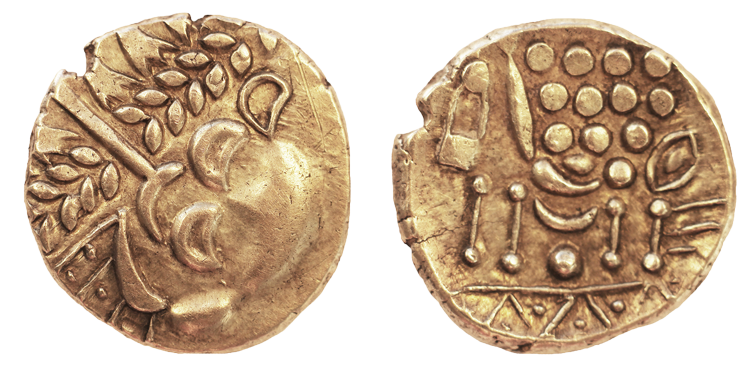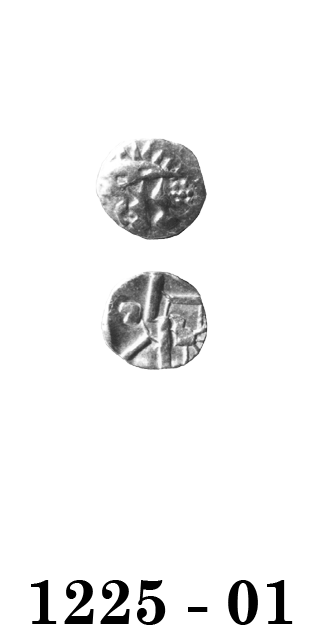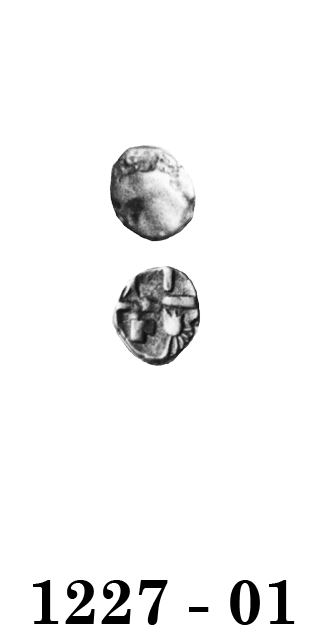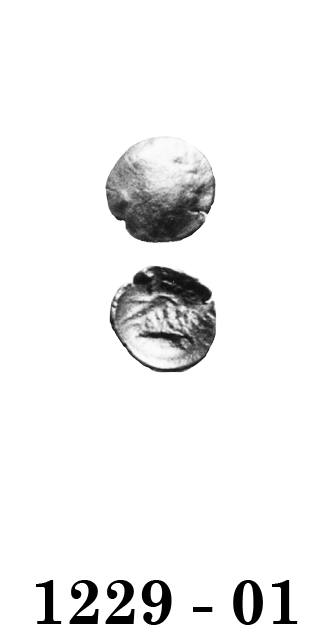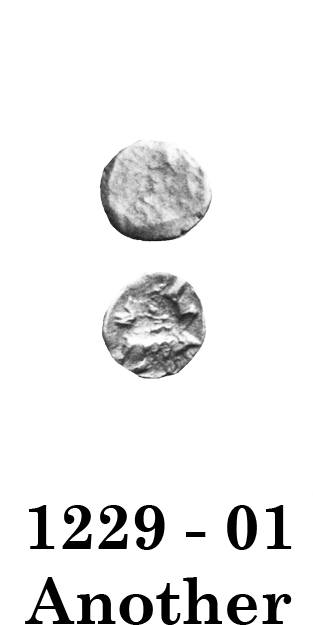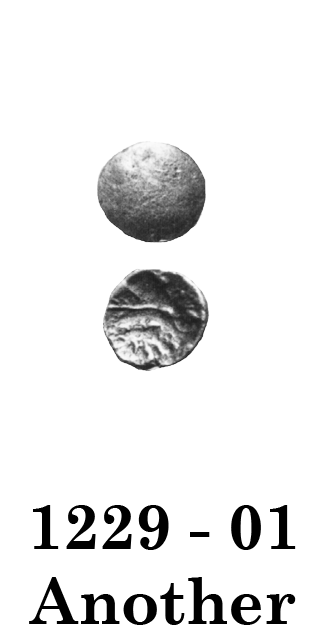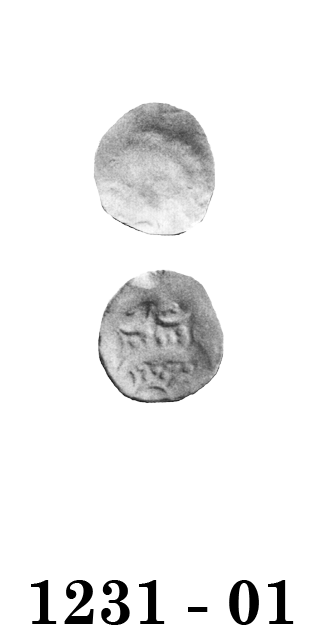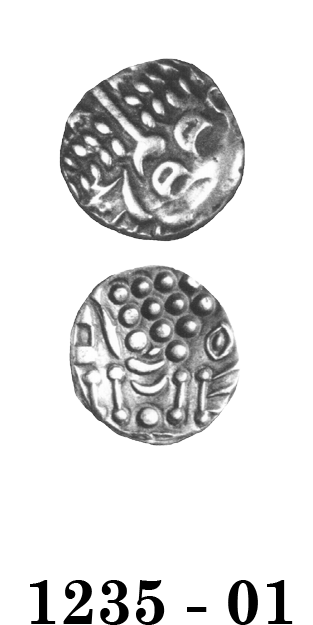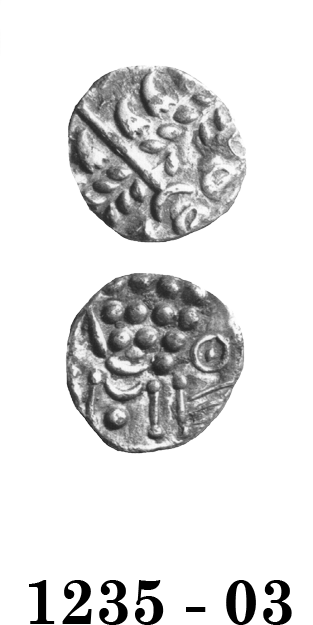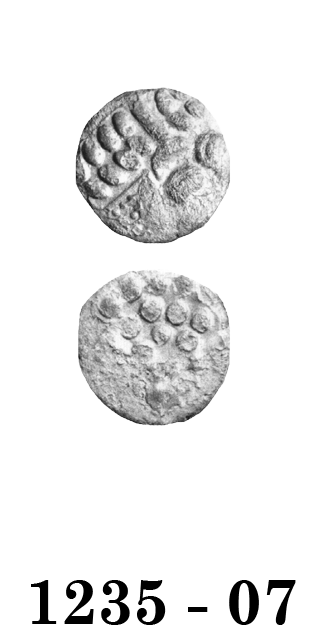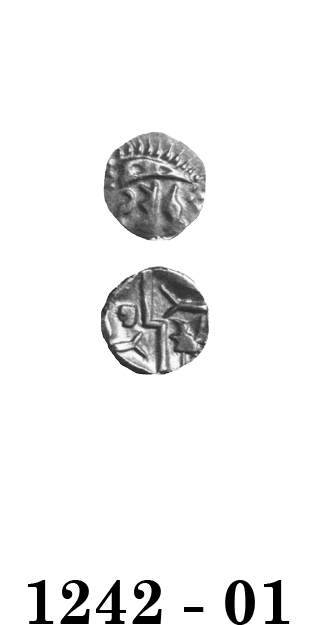
Celtic Coinage of Britain
third edition
Click on coin to see hidden information
Durotrigan Gold Coinage
The first gold coins were struck after the appearance of the Westerham Type of the Atrebates. The Durotrigan adaptation replaced the pellet below the horse with a crab-like object, and placed a "bug" above the animal. These coins were gradually replaced with more debased types, probably intended for external trade in Britain. The tribe's internal coinage became entirely silver around the middle of the Gallic War.
The earliest gold pieces are reasonably common today, not because they were struck in large quantities, but rather because of several hoards found the last century, one near Chute.
There have been recent attempts to reassign these coins to the territory of the Atrebates/Regni/Belgae, but the evidence is increasingly doubtful.
Durotrigan White Gold, Silver and Billon Coinages
The transition from gold to silver coins is indistinct. The Quarter staters become white gold, silver and then billon all with no apparent changes in style or privy marks. The silver staters actually begin as white gold coins, but rapidly degrade to silver and finally billon. The billon types have many varieties, some possibly the products of local or irregular mints.
A new series of quarters, the starfish type, is entirely within the billon series. Two major varieties of starfish quarters distinguished by the thickness of the flan, are known. Most of these types are common today, because a hoard of well over 800 pieces was discovered in the vicinity of Badbury Rings hillfort.
The metallurgical and typological sequences of the coins are problematic and the dating uncertain the following treatment is somewhat arbitrary. An alternative interpretation, not used here, is that several mints were striking coins without centralized control.
Example of 1235 - 01 in white gold
Peter Northover notes these early "silver" coins contain about 9% gold (Northover, 1992, p.249)
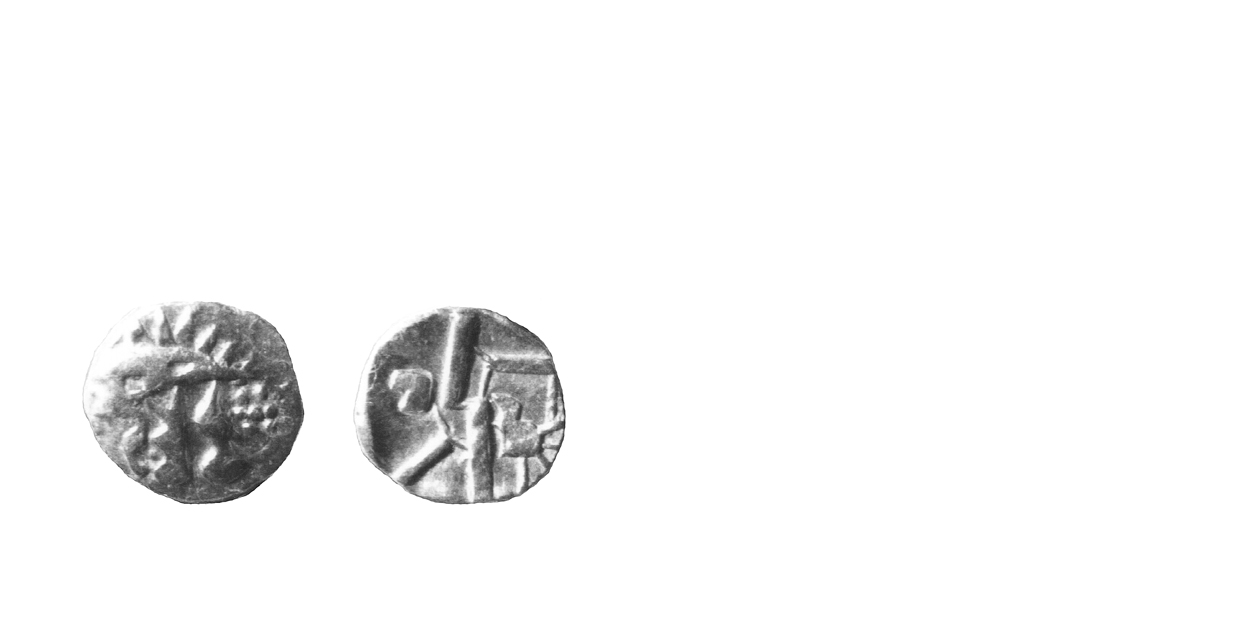
1225 - 01 Early Geometric Type
65-58 B.C. Common
Gold Quarter Stater 1.4 gms. 11 mm
Earliest Record: Mack, 1953
OBV: Pattern
Identifying points:
1) large crescent with one end squared off
2) three appendages hang from crescent
3) daisy to right of appendages
REV: Geometric pattern
Identifying points:
1) vertically-oriented zigzag across field
2) "bird" to right
3) six-sided irregular object to left
4) Y-like object on either side of zigzag
CLASSIFICATION: Durotrigan A
NOTES:
- The obverse image may represent a stylized wolf-and-twins motif
- It has also been suggested the obverse, oriented upside-down, represents a boat with three occupants
- There is little way to prove which interpretion is correct, despite the steril debate over this topic
- The type is derived from the Ambiani Geometric Type
- The typical weight is given
- The metal is gradually reduced to white gold, silver and then billon. It is difficult to separate the issues without metallurgical analysis.
- Silver pieces have been chemically treated to look like the white gold variety by modern forgers. These have a dark reddish appearance and porous surfaces – caveat emptor!
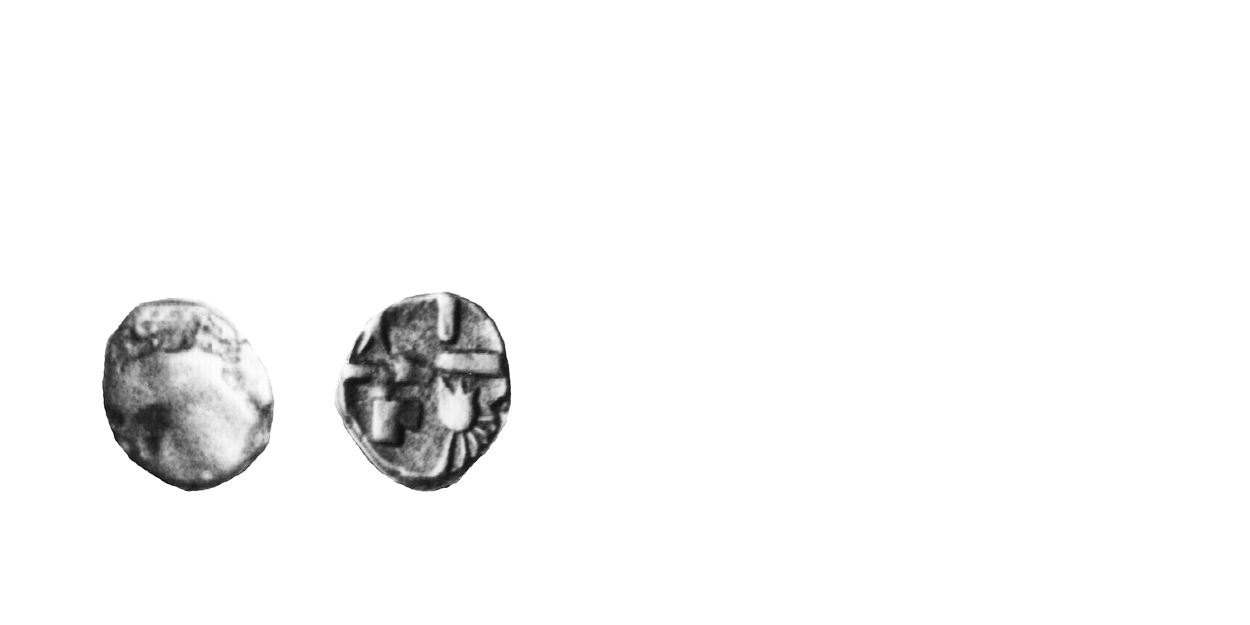
1227 - 01 Early Geometric Type
65-58 B.C. Rare
Gold Quarter Stater 10 mm
Earliest Record: Evans, 1890
OBV: Almost plain
Identifying points:
1) portions of geometric pattern may appear
REV: Geometric pattern
Identifying points:
1) similar to 1225-1
CLASSIFICATION: Durotrigan A
NOTES:
- Many are in museums
- Celtic Coin Index now indicates commoner than previously thought
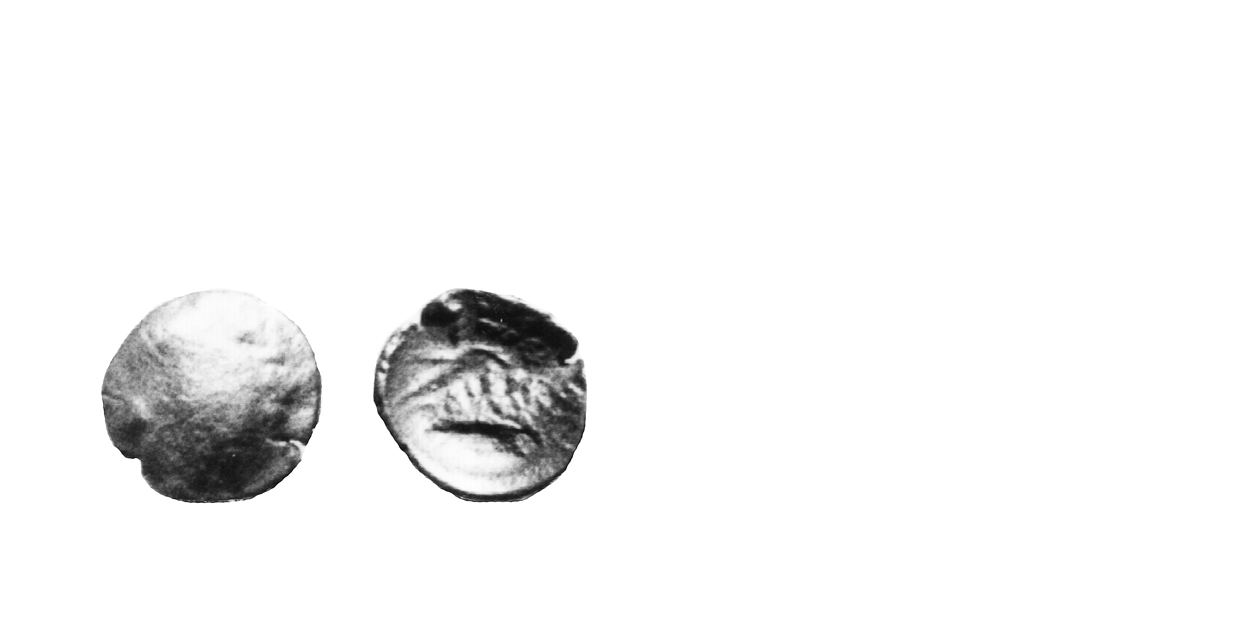
1229 - 01 Early Geometric Type
65-58 B.C. Rare
Gold Quarter Stater 11 mm
Earliest Record: Mack, 1953
OBV: Almost plain
Identifying points:
1) portions of geometric pattern may appear
REV: Geometric pattern
Identifying points:
1) pattern indistinct
2) pattern made up of lines
CLASSIFICATION: Durotrigan A
NOTES:
- Celtic Coin Index now indicates commoner than previously thought
- Most are in museums
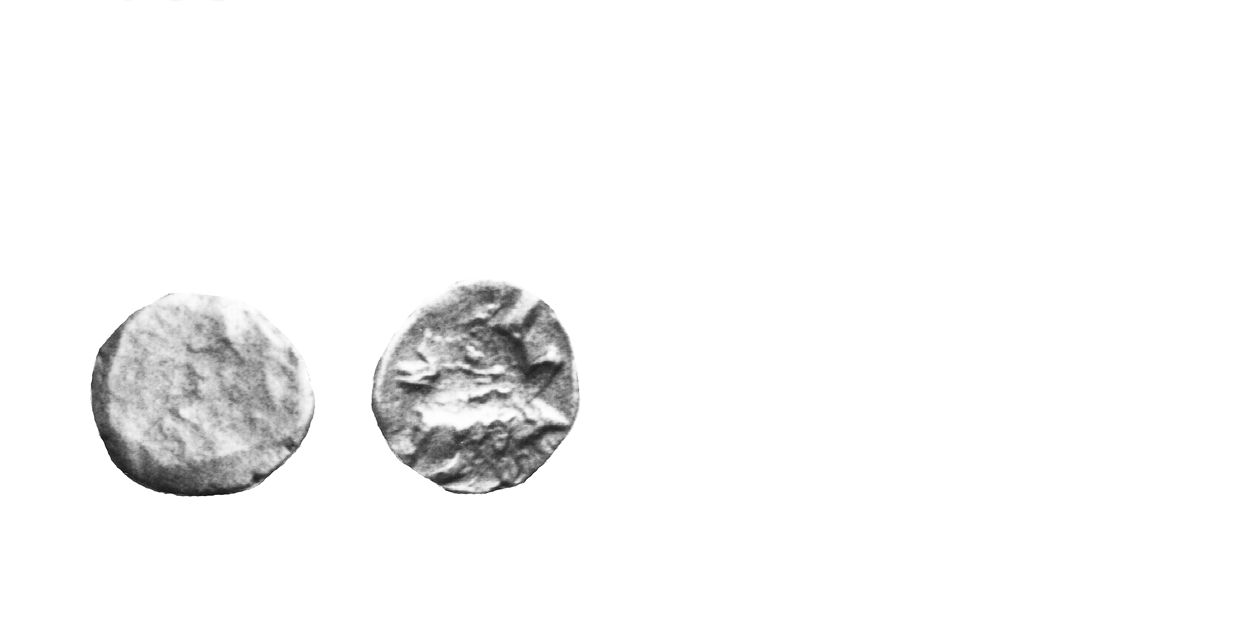
1229 - 01 Early Geometric Type
65-58 B.C. Rare
Gold Quarter Stater 11 mm
Earliest Record: Mack, 1953
OBV: Almost plain
Identifying points:
1) portions of geometric pattern may appear
REV: Geometric pattern
Identifying points:
1) pattern indistinct
2) pattern made up of lines
CLASSIFICATION: Durotrigan A
NOTES:
- Celtic Coin Index now indicates commoner than previously thought
- Most are in museums
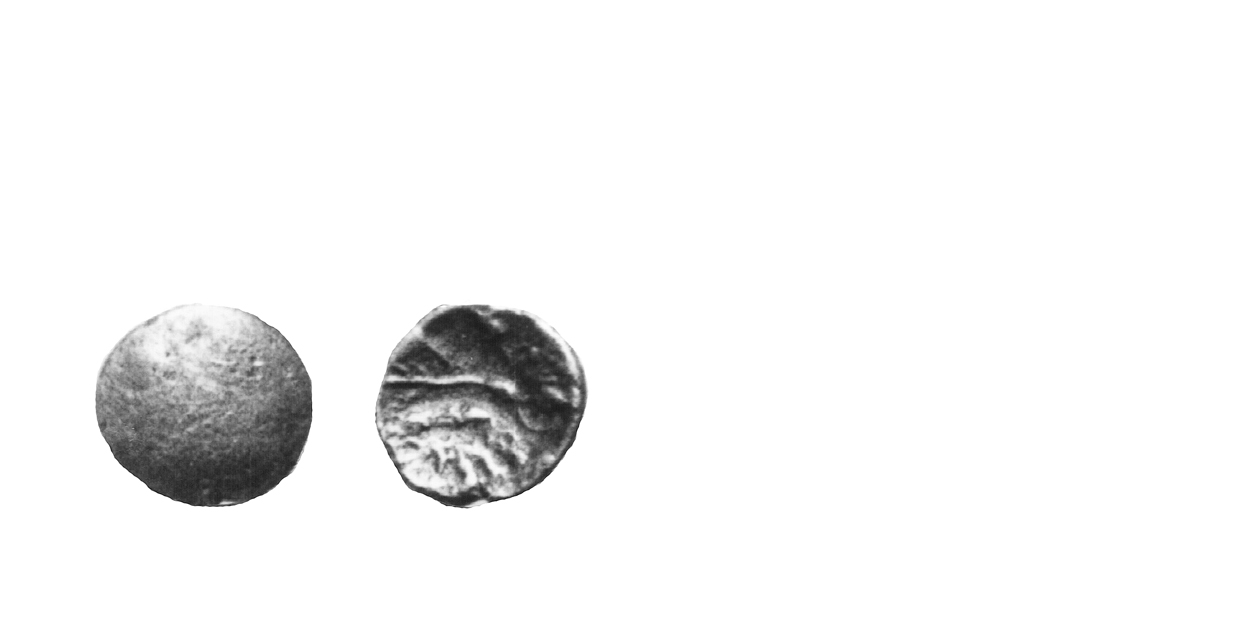
1229 - 01 Early Geometric Type
65-58 B.C. Rare
Gold Quarter Stater 11 mm
Earliest Record: Mack, 1953
OBV: Almost plain
Identifying points:
1) portions of geometric pattern may appear
REV: Geometric pattern
Identifying points:
1) pattern indistinct
2) pattern made up of lines
CLASSIFICATION: Durotrigan A
NOTES:
- Celtic Coin Index now indicates commoner than previously thought
- Most are in museums
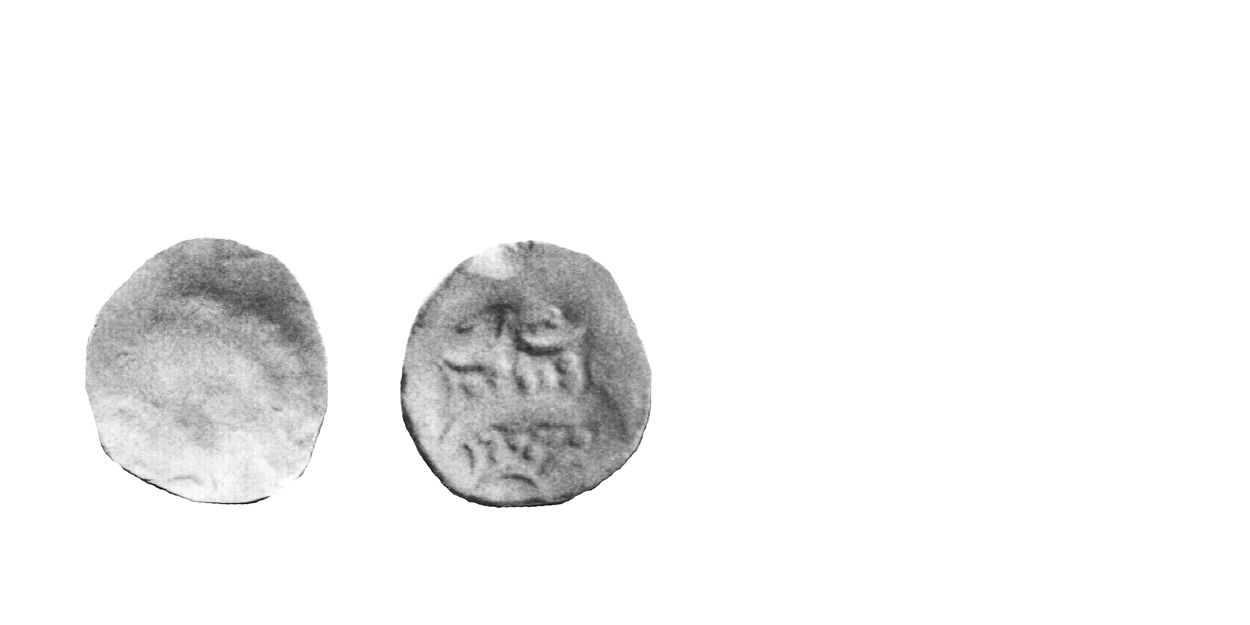
1231 - 01 Uncertain Geometric Type
65-58 B.C. Extremely Rare
Gold and Silver mixed Quarter Stater 1.3 gms. 14 mm
Earliest Record: Palmer, 1871 (see also Evans, 1890)
OBV: Almost plain
Identifying points:
1) possibly remains of design appear
REV: Geometric pattern
Identifying points:
1) pattern indistinct
2) pattern made up of lines and pellets
CLASSIFICATION: None
NOTES:
- Existing example in museum
- Typical weight given
- Possibly Gaulish, see similar type in Scheers pl. 5 number 113
- May have been derived from the Gaulish type
- In the past, this coin has been described as Dobunnic or possibly Silurian, based on an Ariconium findspot. The most likely suggestion is that it is Durotrigan, but this is not certain.
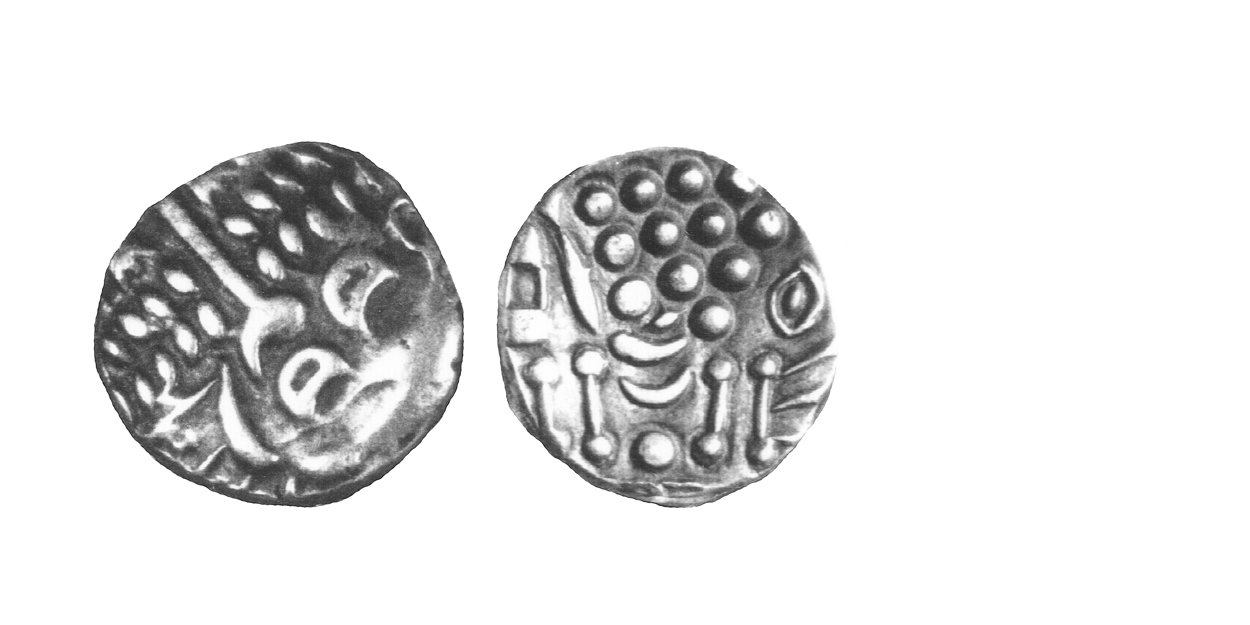
1235 - 01 Abstract Type
58-45 B.C. Common
White Gold, Silver, or Billon Stater 4.9-5.8 gms. 19 mm
Earliest Record: Evans, 1864
OBV: Abstract head of Apollo right
Identifying points:
1) wreath: leaves up
REV: Disjointed horse left
Identifying points:
1) pellet below horse
2) tiny elliptical pellet above horse
3) tail has three strands and points upwards
4) coffee bean above tail
CLASSIFICATION: Durotrigan E
NOTES:
- Some in museums
- The type starts as a white gold coin, but immediately degrades to silver, then billon
- White gold coins, and those of good silver are uncommon, most extant pieces are billon
- White gold pieces are most likely Very Rare to Rare
- Imagery similar to the NorthernWesterham Type of the Atrebates/Regni/Belgae
- Modern forgery exists – (see 1235 - 01F)
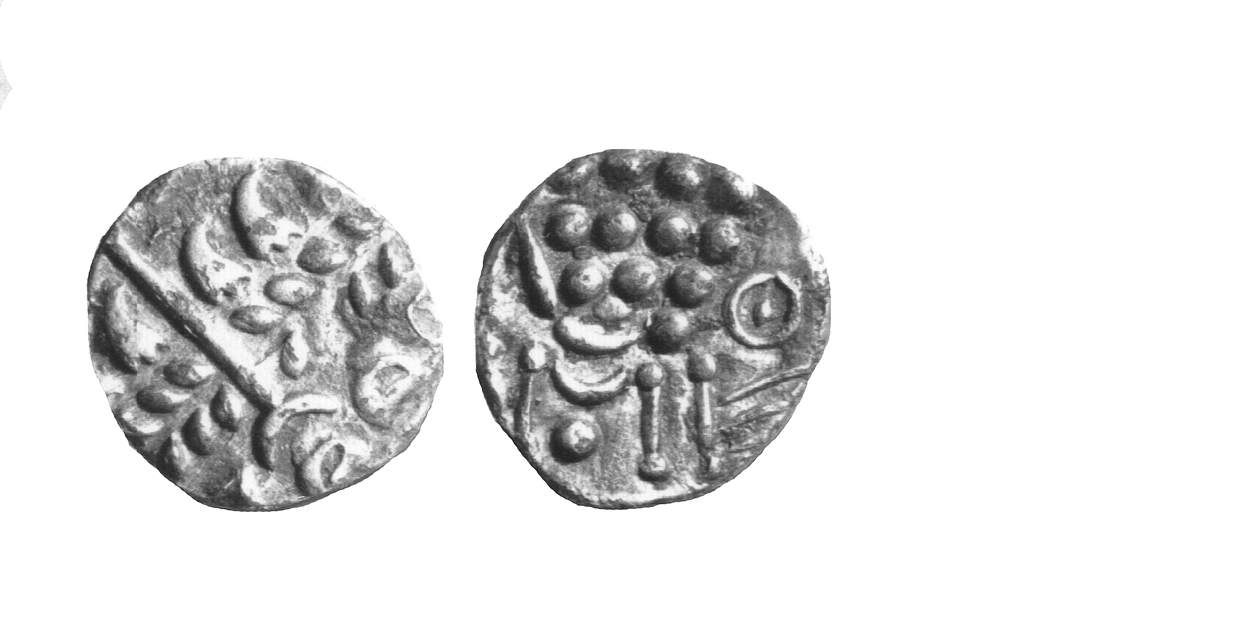
1235 - 03 Abstract Type
58-45 B.C. Scarce
Silver/Bronze Plated Stater 4.7 gms. 19 mm
Earliest Record: Van Arsdell, 1989
OBV: Abstract head of Apollo right
Identifying points:
1) as 1235 - 01, but a bit cruder
REV: Disjointed horse left
Identifying points:
1) as 1235 - 01, but a bit cruder
CLASSIFICATION: Durotrigan E
NOTES:
- Ancient forgery, struck from forger's dies
- Laurel leaf filled in on die, not struck up on coin
- Celtic Coin index now indicates commoner than previously thought
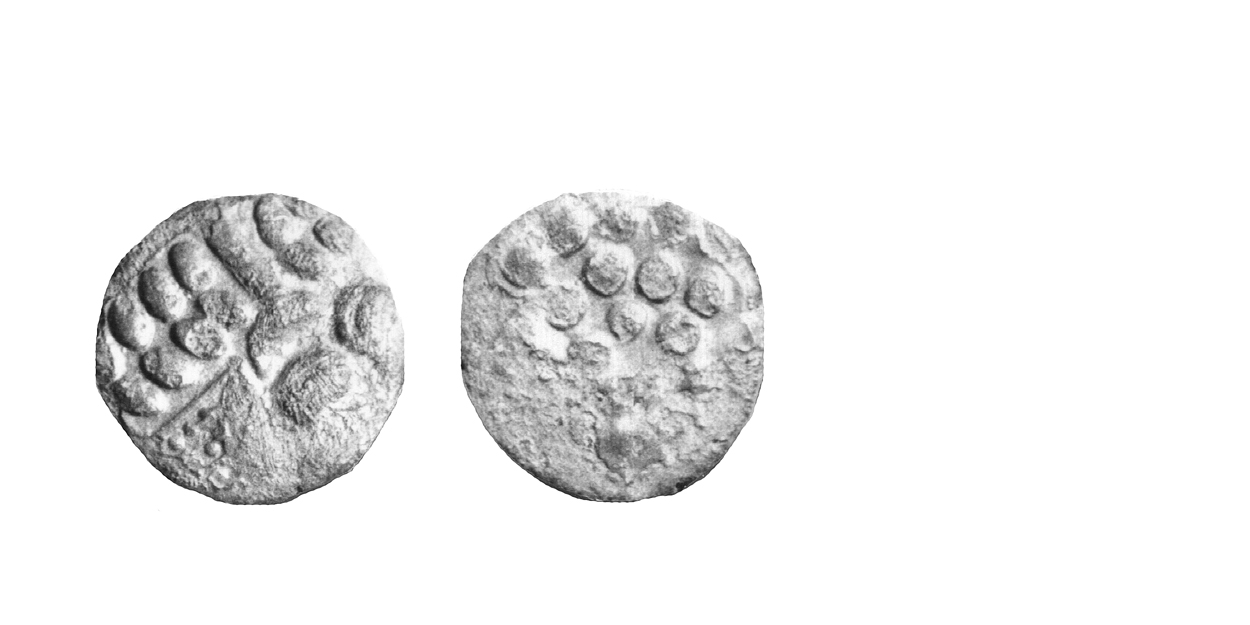
1235 - 07 Abstract Type
58-45 B.C. Extremely Rare
Silver/Bronze Plated Stater 3.2 gms. 17 mm
Earliest Record: Van Arsdell, 1989
OBV: Abstract head of Apollo right
Identifying points:
1) as 1235 - 01, but cruder
2) wreath: leaves down
REV: Disjointed horse left
1) as 1235 - 01 but cruder
CLASSIFICATION: Durotrigan E
NOTES:
- Ancient forgery struck from forger's dies
- Forger blundered direction of laurel leaves, which was always carefully oriented on genuine dies

1242 - 01 Later Geometric Type
58-45 B.C. Common
White Gold, Silver or Billon Quarter Stater 1.l gms. 11 mm
Earliest Record: Allen, 1959
OBV: Pattern
Identifying points:
1) large crescent with one end squared off
2) three appendages hang from crescent
3) daisy to right of appendages
REV: Geometric Pattern
Identifying points:
1) vertically-oriented zigzag across field
2) "bird" to right
3) six-sided irregular object to left
4) Y-like object on either side of zigzag
CLASSIFICATION: Durotrigan E
NOTES:
- The obverse image may represent a stylized wolf-and-twins motif (Cutting, 1978)
- It has also been suggested (Muret and Chabouillet, 1889, p.198) that the obverse, oriented upside-down, represents a boat with three occupants
- There is little way to prove which interpretion is correct
- The type is derived from the Ambiani Geometric Type
- Typical weight is given
- The metal is gradually reduced from gold to white gold, silver and ultimately billon
- It is difficult to separate the issues without metallurgical analysis
- Silver pieces have been chemically treated to look like the white gold variety by modern forgers. These have a dark reddish appearance and porous surfaces – caveat emptor!
The Coinage of the Durotriges
The Durotriges occupied all of Dorset, parts of Somerset, Wiltshire and Hampshire. They had extensive trading contacts with the Armorican peninsula and consequently their coinage was unlike that of the other British tribes. Armorican coins were primarily silver and billon, and the bulk of the Durotrigan coinage was made of these metals instead of gold.
After their first issues, the Durotriges ignored the mainstream of British coinage, suggesting they were economically isolated. Moreover, their coins circulated less and less beyond the tribal boundaries as time went on, and as the tribe's isolation increased.
Initially however, the Durotrigan coinage was an integral part of the economy of southern Britain. Their first coins were inspired by those of the Atrebates/Regni and these did circulate beyond the tribal borders. The CHUTE TYPE, a gold stater first struck about 65 B.C., was adapted from the Southern Westerham Type of the Atrebates/Regni/Belgae. The Durotrigan moneyers evidently struck the staters using the correct alloy and standard weight at the outset. The Atrebatic/Regnan/Belgic influence was short lived, however, for the tribe had converted to an Armorican-style silver coinage by the middle of the Gallic War.
At the beginning of the Gallic War, the Durotriges did two divergent things to their gold coinage. First, they struck a series of gold staters of increasingly lighter weight and lower gold content. The Chute Type was replaced by the CHUTE-CHERITON TRANSITIONAL TYPE and finally the CHERITON TYPE.
One Cheriton Type Stater has been analyzed metallurgically, and has been found to have a high tin content. This suggests the Durotriges were debasing their gold staters with addition of bronze to the alloy. The Cheriton staters perhaps represented an emergency attempt to maintain a gold coinage for trade with the other British tribes. If this was the case, the attempt failed because production soon stopped.
The second change to the coinage was the introduction of a Southern Westerham Type copy in white gold, which rapidly became debased to silver, billon and ultimately bronze. These coins, although occasionally found outside the tribe's territory, were primarily used in the Durotrigan economy since no other tribe used such coins. The series was long-lived, with many types issued in succession. The silver stater and its billon descendants are accompanied by fractional denominations.
Whether the Durotriges went to a silver standard because of the preferences of their Armorican partners, or because they simply ran out of gold bullion, is uncertain. Their trading contacts used mostly silver coins, and by the time of the Gallic War were using them exclusively. After the defeat of the Venetic Fleet and conquest of Armorica by the Romans, the Durotriges ran out of bullion of all types, because their trade with the continent was cut off. They had already been excluded from the British trading networks by strong competition from the Atrebates/Regni/Belgae and Trinovantes/Catuvellauni. Durotrigan silver coins ceased about 30 B.C., and were replaced by struck bronze staters of increasingly crude style. The silver fractional denominations disappeared entirely.
A series of cast bronzes follows, starting probably in the first century A.D., and known mostly from two large hoards. A small number of extremely rare silver coins carrying the inscription CRAB are found in Durotrigan territory. Although these pieces appear Atrebatic/Regnan/Belgic in style, they have been attributed traditionally to the Durotriges because of the findspots.
The Durotrigan coinage would have come to an end in the mid-forties A.D. as Vespasian's legions overran the tribal territory. The tribe offered difficult resistance to the Roman invasion and their coinage would have been ruthlessly suppressed. Durotrigan coins are sometimes found in surprisingly late hoards of Roman pieces, but probably these represented curiosities at the time of deposit.
The site of the Durotrigan mint has never been located with certainty, and several mints may have been in operation. One likely place was the trading port at Hengistbury. Some of the rare varieties of billon staters may have been irregular issues, struck by local authorities.
The moneyers produced flans by the 'Flat Rock' method, pouring molten metal directly on a smooth surface. Some of the coins display splash appendages produced during the flan pouring operation. The Durotriges learned the technique from Armorican moneyers, whose coins also show the appendages. The early gold and silver coins were well-struck, but the later billon ones were hastily produced in enormous numbers and were consequently less well made. The manufacturing methods for the cast coins have never been studied, and represent an opportunity for original research.
A number of plated forgeries of silver staters are known and sometimes it is difficult to distinguish between plated cores and struck bronzes. Conceivably, all struck bronzes may originally have been silver coated.
